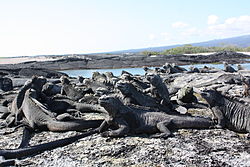Marine iguana
The marine iguana (Amblyrhynchus cristatus) is an iguana found only on the Galápagos Islands. It is the only modern lizard, to live and forage in the sea. Also unusually, it is a vegetarian. It only eats algae.
| Marine iguana | |
|---|---|

| |

| |
| Conservation status | |
| Scientific classification | |
| Kingdom: | Animalia |
| Phylum: | Chordata |
| Class: | Reptilia |
| Order: | Squamata |
| Family: | Iguanidae |
| Genus: | Amblyrhynchus Bell, 1825 |
| Species: | A. cristatus
|
| Binomial name | |
| Amblyrhynchus cristatus Bell, 1825
| |
| Subspecies | |
|
7–11 subspecies; see text | |

| |
The iguana can dive over 9 m (30 ft) into the water. It has spread to all the islands in the archipelago, and is sometimes called the Galápagos marine iguana. It mainly lives on the rocky Galápagos shore to warm from the comparably cold water. It can also be spotted in marshes and mangrove beaches. Charles Darwin described them:
- "The black Lava rocks on the beach are frequented by large (2–3 ft [60–90 cm]), disgusting clumsy Lizards. They are as black as the porous rocks over which they crawl & seek their prey from the Sea. I call them 'imps of darkness'. They assuredly well become the land they inhabit".[2]
Marine Iguana Media
A hybrid iguana, the result of interbreeding between a marine iguana and a Galápagos land iguana
Marine iguanas from Santa Cruz Island (subspecies hassi) are among the largest
Juveniles on Isabela Island
While feeding underwater, marine iguanas are sometimes cleaned by fish, like this Cortez rainbow wrasse. This iguana is on a rock covered in green and red algae, with the usually avoided brown algae behind it.
Lava lizards often scurry over marine iguanas when hunting flies; the iguanas generally ignore these visits
Marine iguanas basking on Fernandina Island
References
- ↑ Nelson, K.; Snell, H. & Wikelski, M. (2004). "Amblyrhynchus cristatus". The IUCN Red List of Threatened Species. 2004: e.T1086A3222951. doi:10.2305/IUCN.UK.2004.RLTS.T1086A3222951.en.
- ↑ Darwin, Charles (2001). Charles Darwin's Beagle Diary. London: Cambridge University Press. p. 494. ISBN 0-521-00317-2.










